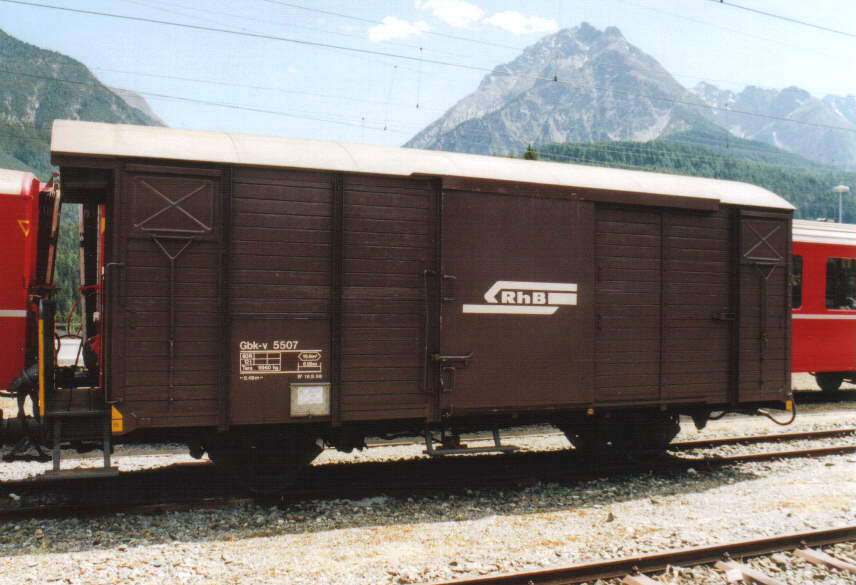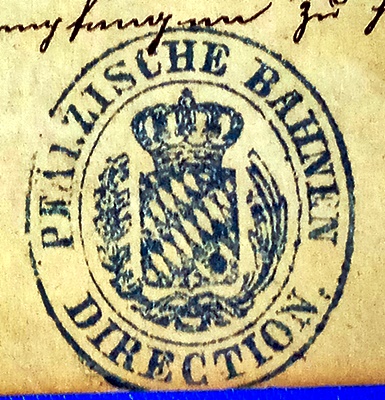|
PwPost Bay 06
The PwPost Bay 06 was a combined mail and luggage van designed for ''Lokalbahn'' branch line train services with the Royal Bavarian State Railways in the early 20th century. It was built to their Design Sheet Number 606. Development As Bavaria's network of ''Lokalbahn'' railways grew so did the requirement for suitable coaches for local passenger transport. Because the only motive power available were tank locomotives with low tractive power, such as the PtL 2/2, coaches of a special lightweight construction were needed. Procurement Between 1905 and 1911 a total of 281 wagons of classes ''BL'', ''BCL'', ''CL'' and ''PPostL'' were procured, all of which - except for the wagons of Class ''PPostL'' - had a uniform floor plan, open platforms at each end with Dixi gates on the steps and gangways only protected by a single iron railing. Large window panes were fitted instead of the composite windows that had been usual up to that point. They are sometimes referred to as 'the shorts ... [...More Info...] [...Related Items...] OR: [Wikipedia] [Google] [Baidu] |
Waggonfabrik Josef Rathgeber
Waggonbaufabrik Josef Rathgeber was a railway coach manufacturer, founded in 1852 in Munich, which closed in 1972. It produced railway vehicles, Motor omnibus, buses, elevators and automatic doors. In 1972 it was taken over by Firma Meiller (company), F. X. Meiller, who use the former factory,Rathgeber-Werk, in München-Moosach to make tilting devices for construction vehicles. Website der Firma Meiller References Transport in Bavaria Rolling stock manufacturers of Germany Vehicle manufacturers of Germany {{transport-stub ...[...More Info...] [...Related Items...] OR: [Wikipedia] [Google] [Baidu] |
MAN SE
MAN SE (abbreviation of ''Maschinenfabrik Augsburg-Nürnberg'', ) was a manufacturing and engineering company based in Munich, Germany. Its primary output was commercial vehicles and diesel engines through its MAN Truck & Bus and MAN Latin America divisions, and participation in the manufacturer Sinotruk. MAN SE was majority-owned by Traton, the heavy commercial vehicle subsidiary of automaker Volkswagen AG, until August 2021 when Traton completed a squeeze out of all remaining shareholders and formally merged MAN SE into Traton SE, meaning the former subsidiaries of MAN SE were now directly owned by Traton, and MAN SE ceased to exist. History Foundation MAN traces its origins back to 1758, when the "St. Antony" ironworks commenced operation in Oberhausen, as the first heavy-industry enterprise in the Ruhr region. In 1808, the three ironworks "St. Antony", "Gute Hoffnung" (English: "Good Hope"), and "Neue Essen" (English: "New Forges") merged, to form the Hüttengewerks ... [...More Info...] [...Related Items...] OR: [Wikipedia] [Google] [Baidu] |
Mail Van
A covered goods wagon or van is a railway goods wagon which is designed for the transportation of moisture-susceptible goods and therefore fully enclosed by sides and a fixed roof. They are often referred to simply as covered wagons, and this is the term used by the International Union of Railways (UIC). Since the introduction of the international classification for goods wagons by the UIC in the 1960s a distinction has been drawn between ordinary and special covered wagons. Other types of wagon, such as refrigerated vans and goods wagons with opening roofs, are closely related to covered wagons from a design point of view. Similar freight cars in North America are called boxcars. Covered goods wagons for transporting part-load or parcel goods are almost as old as the railway itself. Because part-load goods were the most common freight in the early days of the railway, the covered van was then the most important type of goods wagon and, for example, comprised about 40% of th ... [...More Info...] [...Related Items...] OR: [Wikipedia] [Google] [Baidu] |
Luggage Van
A passenger railroad car or passenger car (United States), also called a passenger carriage, passenger coach (United Kingdom and International Union of Railways), or passenger bogie (India) is a railroad car that is designed to carry passengers. The term ''passenger car'' can also be associated with a sleeping car, a baggage car, a dining car, railway post office and prisoner transport cars. The first passenger cars were built in the early 1800s with the advent of the first railroads, and were small and little more than converted freight cars. Early passenger cars were constructed from wood; in the 1900s construction shifted to steel and later aluminum for improved strength. Passenger cars have increased greatly in size from their earliest versions, with modern bi-level passenger cars capable of carrying over 100 passengers. Amenities for passengers have also improved over time, with developments such as lighting, heating, and air conditioning added for improved passenger com ... [...More Info...] [...Related Items...] OR: [Wikipedia] [Google] [Baidu] |
Lokalbahn
A ''Lokalbahn'' or ''Localbahn'' ("local line", plural: -en) is a secondary railway line worked by local trains serving rural areas, typically in Austria and the south German states of Bavaria and Baden-Württemberg. ''Lokalbahnen'' appeared at the end of the 19th century before the use of cars became widespread. Development Because the construction and operation of main line railways was not always covered by their income, simpler solutions were sought. As early as 1865 the engineering conference of the Union of German Railway Administrations (''Verein Deutscher Eisenbahnverwaltungen'') had set out the principles for secondary lines. These were enshrined in law in 1878 with the Railway Act for German Railways of Secondary Importance (''Bahnordnung für deutsche Eisenbahnen untergeordneter Bedeutung''). Bavaria By the 1880s, the Bavarian main line network was largely completed and attention now turned to its expansion into the hinterland. On 21 April 1884 the first Bavarian ... [...More Info...] [...Related Items...] OR: [Wikipedia] [Google] [Baidu] |
Royal Bavarian State Railways
The Royal Bavarian State Railways (''Königliche Bayerische Staats-Eisenbahnen'' or ''K.Bay.Sts.B.'') was the state railway company for the Kingdom of Bavaria. It was founded in 1844. The organisation grew into the second largest of the German state railways (after that of the Prussian state railways) with a railway network of 8,526 kilometres (including the Palatinate Railway or ''Pfalzbahn'') by the end of the First World War. Following the abdication of the Bavarian monarchy at the end of the First World War, the 'Royal' title was dropped and on 24 April 1920 the Bavarian State Railway (''Bayerische Staatseisenbahn''), as it was now called, was merged into the newly formed German Reich Railways Authority or Deutsche Reichseisenbahnen as the Bavarian Group Administration (''Gruppenverwaltung Bayern''). The management of the Bavarian railway network was divided into four Reichsbahn divisions: Augsburg, Munich, Nuremberg and Regensburg. The former Palatinate Railway formed the ... [...More Info...] [...Related Items...] OR: [Wikipedia] [Google] [Baidu] |
Tank Locomotive
A tank locomotive or tank engine is a steam locomotive that carries its water in one or more on-board water tanks, instead of a more traditional tender. Most tank engines also have bunkers (or fuel tanks) to hold fuel; in a tender-tank locomotive a tender holds some or all of the fuel, and may hold some water also. There are several different types of tank locomotive, distinguished by the position and style of the water tanks and fuel bunkers. The most common type has tanks mounted either side of the boiler. This type originated about 1840 and quickly became popular for industrial tasks, and later for shunting and shorter-distance main line duties. Tank locomotives have advantages and disadvantages compared to traditional locomotives that required a separate tender to carry needed water and fuel. History Origins The first tank locomotive was the ''Novelty'' that ran at the Rainhill Trials in 1829. It was an example of a ''Well Tank''. However, the more common fo ... [...More Info...] [...Related Items...] OR: [Wikipedia] [Google] [Baidu] |
Bavarian PtL 2/2
The Class PtL 2/2 locomotives of the Royal Bavarian State Railways (''Königlich Bayerische Staatseisenbahn'') were light and very compact superheated steam locomotives for operation on Bavarian branch lines (known generally as ''Lokalbahnen''). There were three types in total, of which two were transferred to the Deutsche Reichsbahn-Gesellschaft as Class 98.3 tank locomotives and even survived to join the Deutsche Bundesbahn fleet after the Second World War. Common to all the variants was the B axle arrangement (European or UIC classification) or 0-4-0 (Whyte notation), the semi-automatic, gravity-feed firing that enabled one-man operation, and platforms with guard rails, front and rear, that enabled safe access to the coaches. The locomotives had a large driver's cab with 3 windows per side that surrounded the entire locomotive boiler as far as the smokebox. This unique feature earned it the nickname ''Glaskasten'' ("glass box") or, in Franconia, ''Glas-Chaise'' ("glass carria ... [...More Info...] [...Related Items...] OR: [Wikipedia] [Google] [Baidu] |
Palatine Railways
The Palatine Railways (german: Pfälzische Eisenbahnen), often abbreviated to Palatinate Railway (''Pfalzbahn'') was the name of the railway division and administration responsible for all private railway companies in the Bavarian Palatinate from 1844 to 1908. The railway division was first located in the provincial capital of Speyer and later relocated to Ludwigshafen am Rhein. The company was inaugurated with the construction of the Palatine Ludwig Railway (''Pfälzische Ludwigsbahn'') by the eponymous railway company. On the completion of the Palatine Maximilian Railway (''Pfälzische Maximiliansbahn'') the operational headquarters and management of the Palatine Maximilian Railway Company was also incorporated. In 1862, it was joined by the Neustadt - Dürkheim Railway Company (''Neustadt-Dürkheimer Eisenbahn-Gesellschaft''). The same happened to the Palatine Northern Railway Company (''Gesellschaft der Pfälzischen Nordbahnen'') in 1870. In 1869 all the general shareh ... [...More Info...] [...Related Items...] OR: [Wikipedia] [Google] [Baidu] |
Underframe
An underframe is a framework of wood or metal carrying the main body structure of a railway vehicle, such as a locomotive, carriage or wagon. See also * Chassis * Headstock * Locomotive bed * Locomotive frame * Undercarriage Undercarriage is the part of a moving vehicle that is underneath the main body of the vehicle. The term originally applied to this part of a horse-drawn carriage, and usage has since broadened to include: *The landing gear of an aircraft. *The ch ... References {{rail-stub Locomotive parts ... [...More Info...] [...Related Items...] OR: [Wikipedia] [Google] [Baidu] |
Verein Deutscher Eisenbahnverwaltungen
The Union of German Railway Administrations (german: Verein Deutscher Eisenbahnverwaltungen) or VDEV emerged in 1847 from the Association of Prussian Railways (''Verband der preußischen Eisenbahnen''), which had been founded on 10 November 1846 by the ten Prussia Prussia, , Old Prussian: ''Prūsa'' or ''Prūsija'' was a German state on the southeast coast of the Baltic Sea. It formed the German Empire under Prussian rule when it united the German states in 1871. It was ''de facto'' dissolved by an em ...n railway administrations in order to simplify the standardisation of resources, equipment and regulations between the individual administrations. From 1932 it operated under the name of the Union of Central European Railway Administrations (''Verein Mitteleuropäischer Eisenbahnverwaltungen'') or VMEV. Defunct railway companies of Germany Transport in Prussia {{Germany-rail-transport-stub ... [...More Info...] [...Related Items...] OR: [Wikipedia] [Google] [Baidu] |
Screw Coupling
Buffers and chain couplers (also known as "buffers and screw", "screw", "screwlink", and "English" couplers) are the de facto UIC standard railway stock coupling used in the EU and UK, and on some surviving former colonial railways, such as in South America and India, on older rolling stock. Buffers and chain couplers are an assembly of several devices: buffers, hooks and links, or turnbuckle screws. On the modern version of the couplers, rail vehicles are mated by manually connecting the end link of one chain which incorporates a turnbuckle screw into the towing hook of the other wagon, drawing together and slightly compressing the buffer pairs, one left and one right on each headstock. That limits slack, and lessens shunting shocks in moving trains. By contrast, vehicles fitted with the semi-automatic Janney Type E coupler can experience significant jarring during mating and shunting. Very early rolling stock had "dummy buffers", which were simple rigid extensions of the ... [...More Info...] [...Related Items...] OR: [Wikipedia] [Google] [Baidu] |








.jpg)